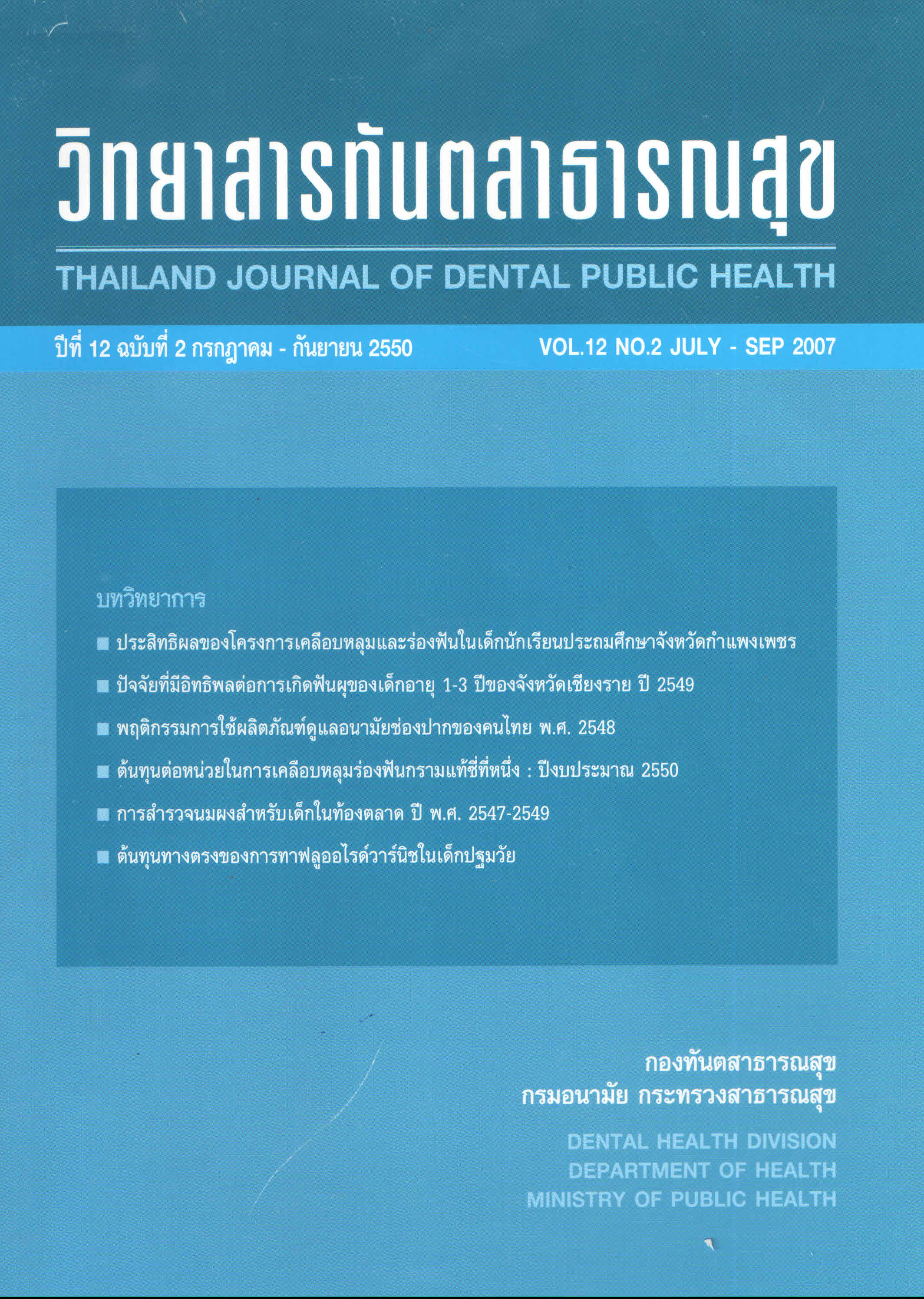Child formula survey in Thailand in 2004 – 2006.
Main Article Content
Abstract
The aim of this study was to survey amount of sugar in the ingredient of child formula in 2004 - 2006, The child formula were classified into 3 subgroups which were infant formula, Follow - up formula and Powdered whole milk. The result of this study was, for infant formula, all brands had no sugar in their ingredients but they still had lactose, which the lactose amount varied among each brands. For the Follow-up formula, ratio of regular formula and sweetened formula raised from 2.3. in
n 2005 and then in 2006 all of the Follow-up formula turned to be regular formula after the launch of the act 286 of Ministry of Public Health. For the Powdered whole milk, ratio of regular formula and sweetened formula increased just a little from 1.7 in 2004, to 2.2 in 2005, the Powdered whole milk was still the group that could be sugar added because there was still no law to control sugar in this group. The survey in 2006 found that there were warning labels “no sugar” on packages, according to the act 286 of Ministry of Public Health. However, this act didn't control sugar adding in the Follow-up formula, so, children still had risk of receiving too much sugar from their milk. From this study, it's recommended that it's necessary to campaign drinking no sugar milk to parents and try to systematically control sugar in children's milk continuously.
Downloads
Article Details
References
2. World Health Organization. Diet , nutrition and the prevention of chronic diseases. WHO technical report series 916. Geneva, World Health Organization, 2003: 109 - 113 & 147 (Annex).
3. http://www.hsph.harvard.edu/prc/ planet.html
4. Statement from the American Academy of Pediatrics for the Senate Subcommittee on Competition, Foreign Commerce and Infrastructure on the Rise of Childhood Obesity. American Academy of Pediatrics. March 2004.
5. Arnold H. Slyper. The Pediatric Obesity Epidemic: Causes and Controversies. J Clin Endocrinal Metab, June 2004, 89(6) :2540-2547.
6. David S Ludwig, Karen E Peterson, Steven L Gortmaker. Relation between consumption of sugar-sweetened drinks and childhood obesity: a prospective, observational analysis. THE LANCET. Vol 357, February 17, 2001
7. ฤดี สุราฤทธิ์, น้ําตาล กรุงเทพฯ : โรงพิมพ์ ออนพริ้นซ้อพ : 2549
8. บุบผา ไตรโรจน์ จันทนา อึ้งชูศักดิ์ วิไลลักษณ์ บังเกิดสิงห์ และสุรางค์ เชษฐพฤนท์, การศึกษา สถานการณ์การบริโภคนมของเด็กวัยก่อนเรียน ในศูนย์เด็กเล็ก พ.ศ. 2546. ว.ทันต.สธ 2546; 8(1-2): 31-37.
9. สุริยเดว ทรีปาตี ที่มาที่ไปความหวาน เอกสาร เผยแพร่ในนามเครือข่ายเด็กไทยไม่กินหวาน พ.ศ. 2547
10. Mennella JA, Jagnow CP, Beauchamp GK Prenatal and postnatal flavor learning by human infants. Pediatrics. 2001 Jun; 107(6):E88.
11. ศิริเกียรติ เหลียงกอบกิจ จันทนา อึ้งชูศักดิ์ นโยบายสาธารณะเพื่อลดการบริโภคหวาน ในเด็ก กรณีการ แก้ไขประกาศกระทรวงสาธารณสุขฉบับที่ 156,157
12. ประไพศรี ศิริจักรวาล และอุรุวรรณ แย้มบริสุทธิ์ดูฉลากนมตรงไหนปลอดภัยจากน้ําตาลใน; เลี้ยงลูกอย่างไรห่างไกลโรคอ้วน.กรุงเทพฯ :โรงพิมพ์บริษัทพิมพ์ดี จํากัด : 2547
13. ประกาศกระทรวงสาธารณสุข ฉบับที่ 156 (พ.ศ.2537) เรื่องนมดัดแปลงสําหรับทารก และนมดัดแป สูตรต่อเนื่องสําหรับทารกและเด็กเล็ก
14. ประกาศกระทรวงสาธารณสุข ฉบับที่ 286 (พ.ศ.2547) เรื่องนมดัดแปลงสําหรับทารก และนมดัดแปลงสูตรต่อเนื่องสําหรับทารกและ เด็กเล็ก (ฉบับที่ 2)


